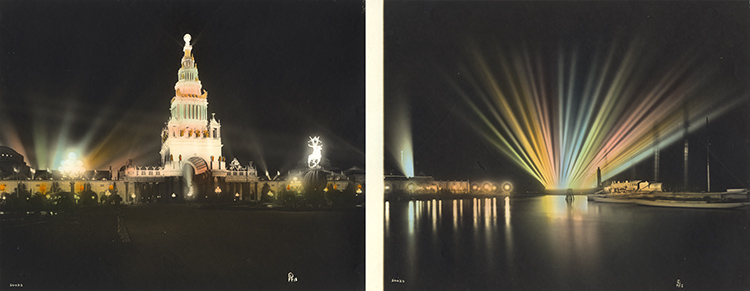San Francisco was host to the 1915 World's Fair, also known as the Panama-Pacific International Exposition (PPIE).

In addition to commemorating the completion of the Panama Canal, the 1915 exposition celebrated San Francisco’s recovery from the ashes of the 1906 earthquake and its emergence as a center of world trade, beauty, progress and innovation. “San Francisco’s innovation, imagination and vision were on full display at the World’s Fair in 1915, and these qualities are at the heart of our City then, now and tomorrow,” said Mayor Ed Lee.
San Francisco’s Ferry Building, a beaux art masterpiece designed by architect A. Page Brown and completed in 1898, was one of the few structures that was not seriously damaged during the earthquake. In 1915, this vital transportation mecca served as a welcoming center for all who visited San Francisco to attend the PPIE—over 18 million visitors!
Until the completion of the Bay Bridge (which originally carried railroad traffic) and the Golden Gate Bridge in the 1930s, the Ferry Building was the second busiest transit terminal in the world, second only to London’s Charing Cross Station. In the 1950s, the Ferry Building fell into disrepair, but in 2002 under the leadership of Mayor Willie Brown it was restored to its original glory.
As a volunteer, San Francisco native Donna Ewald Huggins led the successful campaign to restore the Palace of Fine Arts, and the 1915 exposition has always captured her imagination. Her maternal grandparents courted there, and they told Huggins tales of the wonders they saw. Due to her experience and enthusiasm, Mayor Lee appointed Huggins his mayoral liaison for the 1915 exposition centennial, and she saw an opportunity for a dream of hers to come true—to recreate the Ferry Building’s historic 1915 lighting.
Mayor Lee, Chief of Protocol Charlotte Shultz and Mayor Brown have been ardent supporters of Huggins’ efforts to relight the Ferry Building for the exposition centennial. These public officials approved the project, and all of the project’s supporters will soon see their efforts come to fruition. Jim Phelan and Company has designed and installed the lights, replicating as closely as possible the lighting of 1915. Phelan was assisted by Metropolitan Electric and Data Communications and Sunward Flag.
The lights will be turned on once again on Tuesday, March 3 in a public ceremony. Crowds will gather at 5:30 p.m. with the actual relighting taking place at 6:15. The lights will remain on until December 4, the day in 1915 that the Exposition closed. Don’t miss the magical moment when the Ferry Building once again invites the world to 1915!
Donors who made the project possible include the Port of San Francisco, the Ferry Building, California Historical Society/PPIE100.org, Maurice Kanbar, Platinum Advisors, the Friend Family, Sterling Bank/Seligman Family Foundation, Autodesk, the Maybeck Foundation, Michele and Chris Meany, Bay Crossings and Pier 39. Lead donor Taube Philanthropies—who also made the lead gift to the Bay Lights and facilitated the gift to light the Palace of Fine Arts for the centennial weekend—stepped in and made the generous closing gift that truly made this historic event possible.
Information for this story was obtained from several sources including portions by Laura Ackley, Donna Huggins and Jason Herrington.
----------------------------------------------------------------------------------------------------------------------------------------------------------------------------
Lighting the Expo
Among its many attractions, the 1915 World’s Fair featured indirect lighting for outdoor effects used for the first time at an exposition. General Electric Illuminating Engineer Walter D’Arcy Ryan designed the elaborate and groundbreaking lighting effects. He created, for the first time, a “Total Illumination Plan,” which skeptics claimed could not be realized.
The special lighting effects included the Great Scintillator, the Tower of Jewels and the Electric Kaleidoscope. The Great Scintillator was a battery of 48 spotlights that were projected through colored gels and moved through the famous San Francisco fog to form effects with such evocative names as “Devil’s Fan” and “Fighting Serpents and Octopus.”
Specially designed two-inch cut glass “Novagems” were hung from the central Tower of Jewels to create a constant shimmering effect under the colored spotlights, and a contraption called the Electric Kaleidoscope projected displays evocative of butterflies, sunsets and comets onto the interior of the huge, opalescent glass dome of the Palace of Horticulture.
Most importantly, Ryan’s widespread implementation of hidden architectural floodlighting—which he termed “Indirect Lighting”—changed the standard for architectural illumination forever.
The historic photos below are courtesy of the Seligman Family Foundation.

The 1915 Panama-Pacific International Exposition featured spectacular lighting effects for the time period including the Tower of Jewels (left) and the Electric Kaleidoscope. The Great Scintillator (right) was a battery of 48 spotlights projected through colored gels that created a rainbow of colors piercing through the San Francisco fog that some called the “Devil’s Fan.”

